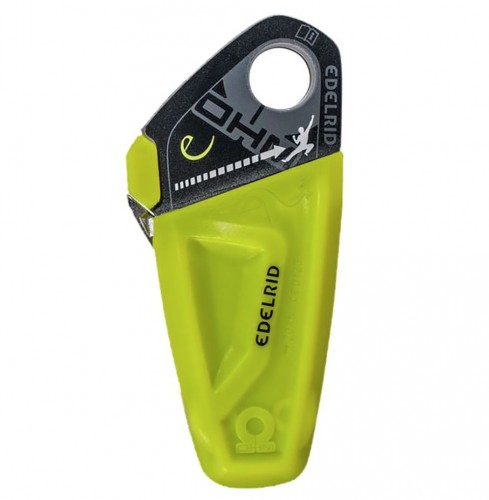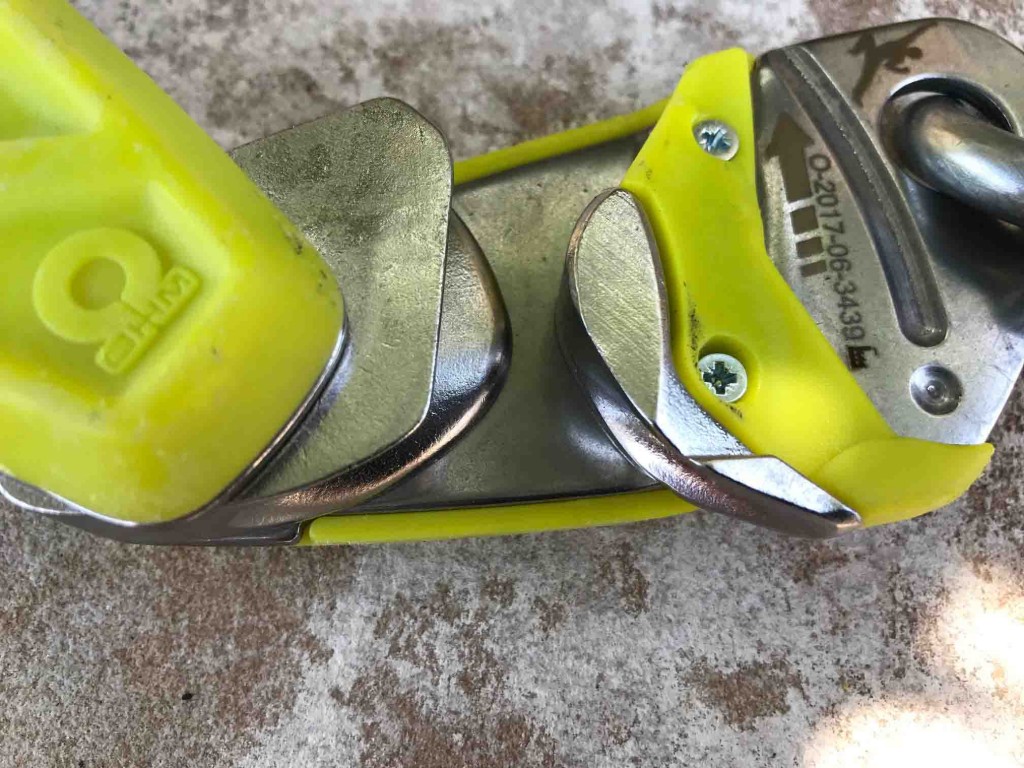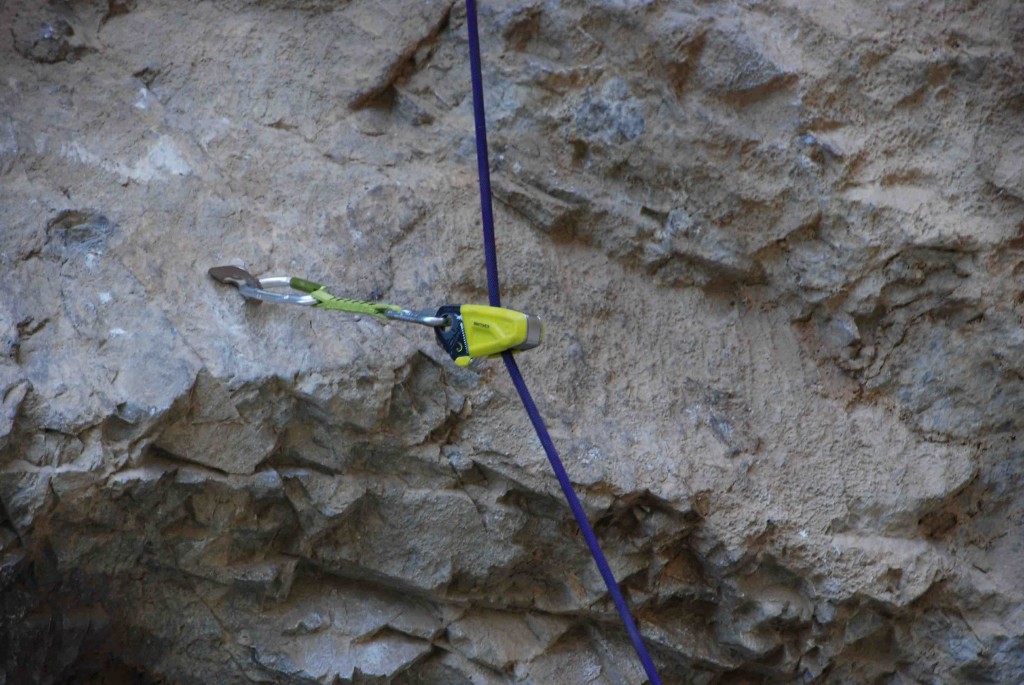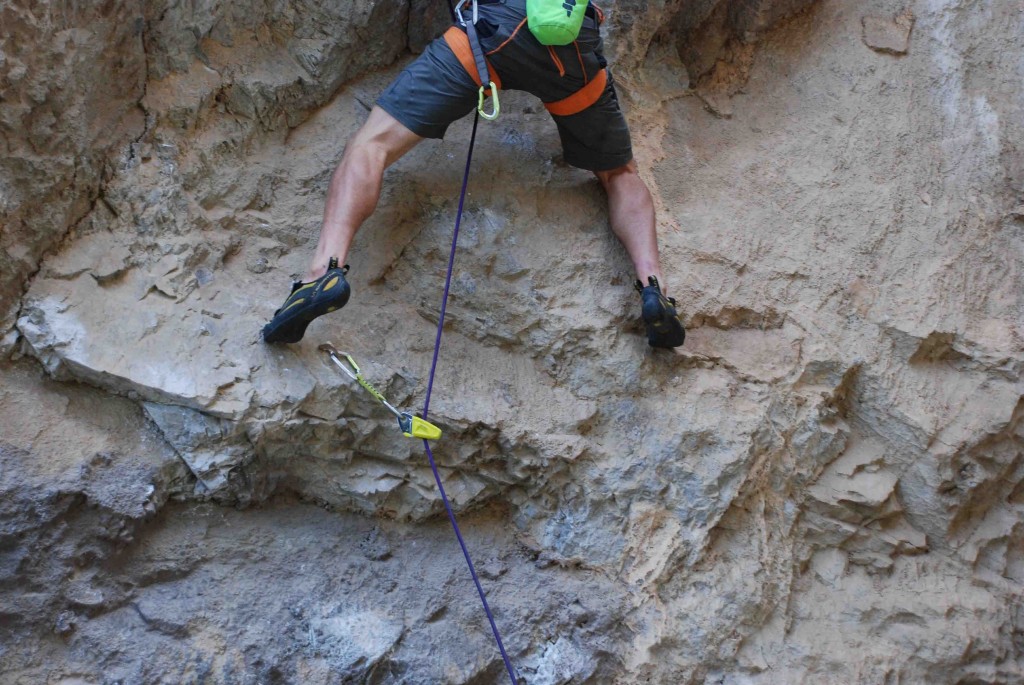Edelrid Ohm Review
Our Verdict
Our Analysis and Test Results
The Edelrid Ohm is a unique device in the climbing market. It's a braking resistor that helps reduce the length of a climber's fall. This device is used in addition to a belay device, and we'll explain the ins and outs of how it functions in our hands-on review below. Edelrid makes certain assertions about the Ohm on their website, including that “rope handling when belaying a lead climber is not affected (no additional friction when paying out rope)” and “lowering a heavier climber is much easier to control.” We don't agree with all of their statements, but do concur that the Ohm “significantly reduces the risk of a possible ground fall.” Note that we won't cover every test metric that we rate the rest of the belay devices with, as this is not quite the same as those products, nor do we have an overall score for the Ohm, as there is nothing else out there like it that we can compare it to!
Performance Comparison
How does it work?
The Ohm slows down and limits the distance that a belayer gets yanked upwards in the case of a leader fall. It doesn't completely eliminate a dynamic belay (that would be painful), but it tries to level the playing field when there is a large weight difference between climber and belayer. For example, when there is a high first bolt, say 10 feet off the ground, that means that the climber could fall an additional 10 feet from anywhere on the route if the belayer gets yanked up all the way to the first bolt, which is not uncommon in big climber/little belayer scenarios. This could result in the climber hitting the belayer or even the ground depending on where they fall on the climb.
There are no moving parts inside the device, unlike say a GriGri, and the device is only engaged once its orientation has changed. When climbing, the rope runs (relatively) smoothly through the device and the unit lays against the wall. When the rope gets pulled taut, it changes the position of the Ohm relative the rope, and now the whole unit has essentially rotated 90 degrees. This engages the camming mechanism, which isn't a full stop on the rope like a GriGri but it does introduce friction, slowing the passage of the rope through it. This is why the belayer won't get yanked up as far.
Use and Set-Up
According to Edelrid, the Ohm is designed for a climbing team with a 10-40 kg (22 to 88 lbs) weight difference. After trying it at the lower end of the weight scale, we feel like it's a more effective tool with a minimum of 30 pounds difference. Anything less seemed unnecessary and also resulted in some hard catches.
Note that Edelrid uses different terminology when talking about the weight differences between the climber and belayer — sometimes they use the actual weight and sometimes the percentage. The sweet spot, according to them, is when there is a 30% difference between the climbers. That could be a 120-pound belayer and a 155-pound climber (35lbs difference, 30% difference), or a 155-pound belayer and a 200-pound climber (45lbs difference, 30% difference). Confused yet? The unit does come with a reference chart if you're unclear of when to use it, though most petite belayers who are experienced climbers probably already have a rough estimate of what size person they can and can't belay safely without this device.
The Ohm comes pre-rigged with a sling and carabiner. Edelrid recommends using their set-up and not changing the length of the sling as this will affect how much the device engages. There's a release button that lets the front swing open so that you can thread the rope through. There is a climber end and a belayer end, so be sure to look carefully at the device when threading it and include it in your buddy check. (If threaded improperly it won't work.) The unit then gets attached to the first bolt.
Feeding Slack
Edelrid states that you don't feel any extra resistance from the device when pulling up slack, but we disagree with that a little. The rope doesn't pull as smoothly through the device as it does through a carabiner, and if the belayer is even a little bit away from the wall, it adds more friction to the system. While belayers should be standing close to the wall whenever possible, sometimes the geography of the crag makes that impossible (there might be a boulder at the base or the rock slabs down at the bottom). As soon as there is a slight angle on the rope as it enters the device, you start to feel more friction when pulling slack through it.
The Ohm is supposed to work for 8.9mm to 11mm ropes. We preferred using it with a 9mm rope, as the climber felt less resistance when clipping.
Catch
When the leader falls and the mechanism engages, the upward force on the belayer is reduced, and they don't get yanked as far off the ground, which is a nice change for those of us who are used to being yarded up high off the ground with each fall and/or slammed into the wall.
Lead climbers reported feeling no difference in the softness of the catch if they were significantly higher than the bolt they fell on, or there was sufficient rope out. At others times though, the catch felt harder on the climber. If you've been keeping minimal slack out for years because you know you'll get yanked upwards and provide a soft catch that way, you may have to start giving a little extra slack when you use the Ohm. Again, these are advanced belaying scenarios that you will personally dial in with regular use of this device. Once the leader takes a fall and the mechanism engages, it stays engaged even when the climber starts moving upwards again. The climber must reach down and jiggle the rope a little to disengage it, which can be annoying when taking multiple times on the same route.
Lowering
Once the climber is ready to lower, the belayer will notice that there is more friction in the system and that a lot of the weight is taken off them. This too is a nice change from lowering a heavier climber and feeling like you are being lifted off the ground and not in control of the situation, and it makes the whole process much safer.m
Weight/Bulk
With the sling and carabiner, the Ohm weighs 16.8 ounces — more than a pound! It feels like a mini brick in your backpack too, though if it saves your life or your ankles, you'll probably be glad you brought it with you. Since it gets placed on the first bolt you don't have to worry about the weight while climbing though.
Durability
While there is some plastic on the housing, the whole camming mechanism is made of stainless steel, and plenty of it. No wonder it is so heavy! Eventually, if parts of the cam are worn away the device might lose some effectiveness, but it will likely take a lot of wear before that happens.
Best Applications
The Ohm was designed primarily for situations where the climber is significantly heavier than the belayer, but it is also a valuable tool in many different scenarios. Even if the climber and belayer don't have a huge weight difference, it can be useful in situations where the base of the route is particularly sketchy, or there is a high first bolt. This device is also useful in gyms and for onsight attempts.
When Not to Use ItThere are some specific situations where you don't want to use this device. Unlike our example at the beginning of this article, where a climber was putting it on every climb regardless, there are some instances where you wouldn't necessarily benefit from this device.
Number one is when traditional climbing. While the first piece of your protection system should always be multi-directional (as the rope will often pull it in an upwards orientation), the Ohm puts additional forces into play and is not made for use with gear.
We tested this mechanism on a route that we were working on (hanging multiple times at every bolt, figuring out the moves, etc.) and found the Ohm highly annoying in this situation. Because you have to jiggle the mechanism free after every take, it seemed like much more hassle than it was worth, particularly once the climber got out of ground fall range.
Other times where you might not want to use this device include a wandering route, one with a large roof, or instances where you might need to pay out extra slack to clear an obstacle. These are all advanced belaying situations.
Value
If you've already spent a pretty penny on the new Petzl GriGri+, you might not be all that inclined to dole out more money for the Ohm. However, we consider the price of this device money well spent considering the safety advantages that it supplies.
Conclusion
The Edelrid Ohm solves a problem that many climbers of all sizes have encountered. If you've ever hesitated to belay a larger person for fear of dropping them or have looked at your petite partner and worried that you might hit the ground, the Ohm is an essential tool for safe belaying. It takes some getting used to and is not suitable for all climbing situations, but it will certainly save some ankles, and maybe even some lives too!











